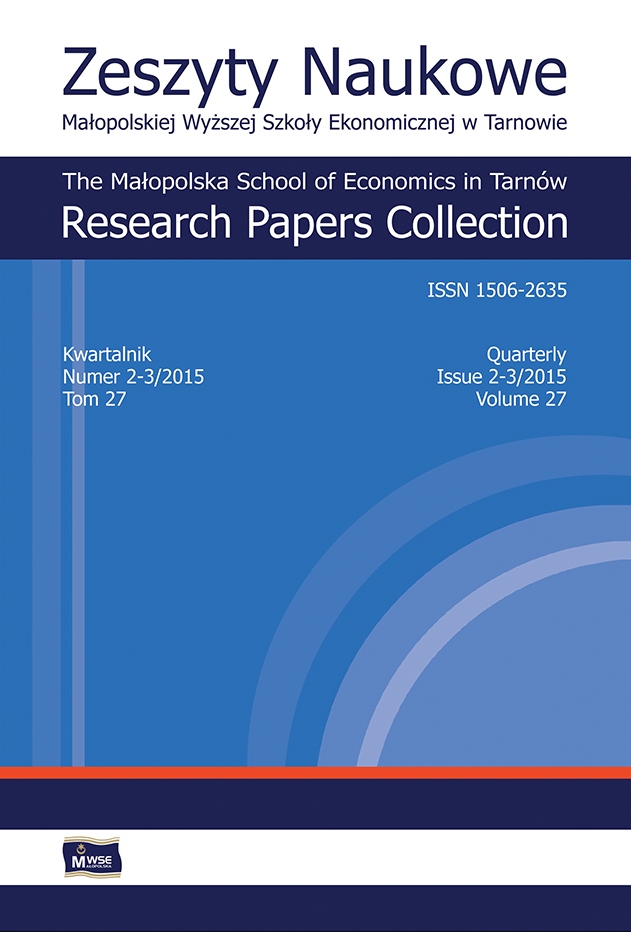Abstrakt
W dążeniu do osiągania przewagi konkurencyjnej istotną rolę odgrywają obecnie rozwiązania przyjęte w obszarze działalności logistycznej przedsiębiorstwa. Jakkolwiek zrozumiałe wydaje się w tym zakresie projektowanie logistyki w sposób ułatwiający przepływ towarów w przedsiębiorstwie oraz pomiędzy przedsiębiorstwami w łańcuchu dostaw, to jednak coraz większą uwagę skupia się na organizacji logistyki zwrotów towarów, odpadów i surowców wtórnych. W systemowym ujęciu logistyki zwrotów odpadów i surowców wtórnych jako inspirację można potraktować system oraz propozycję opisu i analizy systemu zarządzania przedstawioną w pracy pod redakcją Adama Stabryły (2010, s. 21). W zaprezentowanym podejściu uwzględniono potrzebę ujęcia celów systemu, umiejscowienia stanowisk odpowiedzialnych za decyzje w badanym systemie w strukturze organizacyjnej, funkcji i procesów w systemie oraz narzędzi wykorzystywanych w realizacji wyróżnionych procesów. W niniejszym artykule przedłożono propozycję systemowego ujęcia działalności logistycznej w obszarze zwrotów towarów, wycofywania odpadów oraz zagospodarowania surowców wtórnych. Uwzględnione zostały cele takiego systemu, rozwiązania dotyczące stanowisk decyzyjnych w strukturze organizacyjnej, procesy oraz narzędzia wykorzystywane w zarządzaniu działaniami w tym obszarze.
Bibliografia
Beier, F.J., Rutkowski, K. (2004). Logistyka. Warszawa: Szkoła Główna Handlowa – Oficyna Wydawnicza. ISBN 83-86689-06-4.
Zobacz w Google Scholar
Bielski, M. (2001). Organizacje. Istota, struktury, procesy. Łódź: Wydawnictwo Uniwersytetu Łódzkiego. ISBN 83-7171-412-2.
Zobacz w Google Scholar
Griffin, R.W. (2004). Podstawy zarządzania organizacjami. Warszawa: Wydawnictwo Naukowe PWN. ISBN 83-01-14018-6.
Zobacz w Google Scholar
Koźmiński, A.K., Piotrowski, W. (red.) (1998). Zarządzanie. Teoria i praktyka. Warszawa: Wydawnictwo Naukowe PWN. ISBN 83-01-12705-8.
Zobacz w Google Scholar
Lieckens, K., Vandaele, N. (2012). Multi-level reverse logistics network design under uncertainty. International Journal of Production Research, 50(1), 23–40.
Zobacz w Google Scholar
Mitra, S. (2009). Analysis of a two-echelon inventory system with returns. Omega. The International Journal of Management Science, 37(1), 106–115.
Zobacz w Google Scholar
Pfohl, H.Ch. (2001). Systemy logistyczne. Podstawy organizacji i zarządzania. Poznań: Biblioteka Logistyka, Instytut Logistyki i Magazynowania. ISBN 83-87344-10-9.
Zobacz w Google Scholar
Piplani, R., Saraswat, A. (2012). Robust optimisation approach to the design of service networks for reverse logistics. International Journal of Production Research, 50(5), 1424–1437.
Zobacz w Google Scholar
Srivastava, S.K. (2008). Network design for reverse logistics. Omega. The International Journal of Management Science, 36(4), 535–548.
Zobacz w Google Scholar
Stabryła, A. (red.). (2010). Analiza i projektowanie systemów zarządzania przedsiębiorstwem. Kraków: Wydawnictwo Mfiles.pl. ISBN 978-83-931128-07.
Zobacz w Google Scholar
Szołtysek, J. (2009). Logistyka zwrotna. Poznań: Instytut Logistyki i Magazynowania. ISBN 978-83-87344-14-6.
Zobacz w Google Scholar
Trebilcock, B. (2002). Seven deadly sins of reverse logistics. Logistics Management, 41(6), 31–34.
Zobacz w Google Scholar
Tuzkaya, G., Gülsün, B., Önsel, Ş. (2011). A methodology for the strategic design of reverse logistics networks and its application in the Turkish white goods industry. International Journal of Production Research, 49(15), 4543–4571.
Zobacz w Google Scholar
Walker, W.T. (2005). Supply Chain Architecture: A Blueprint for Networking the Flow of Material. Information and Cash. Boca Raton, FL: CRC Press LLC. ISBN 1-57444-357-7.
Zobacz w Google Scholar
© Copyright by Małopolska Wyższa Szkoła Ekonomiczna w Tarnowie. Artykuły są udostępniane na podstawie Creative Commons Attribution Uznanie autorstwa - Użycie niekomercyjne - Bez utworów zależnych 4.0 Licencja Międzynarodowa


